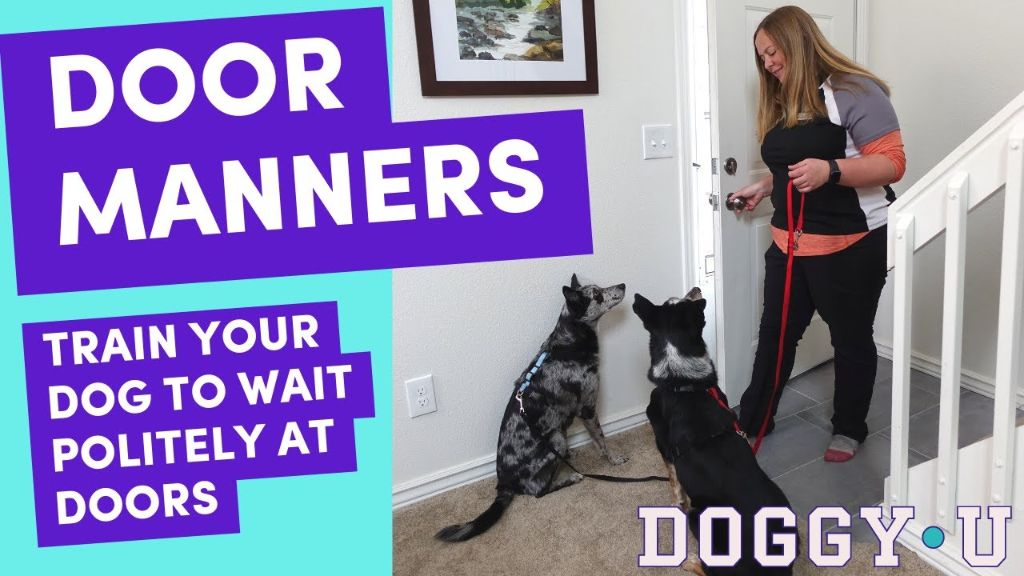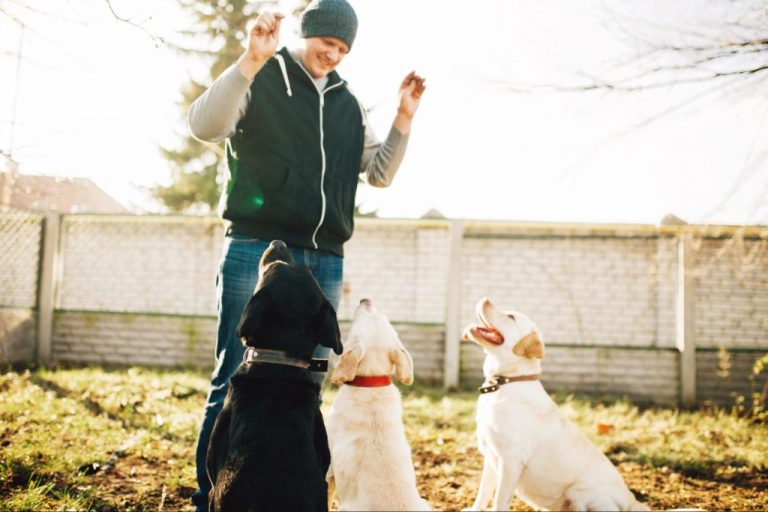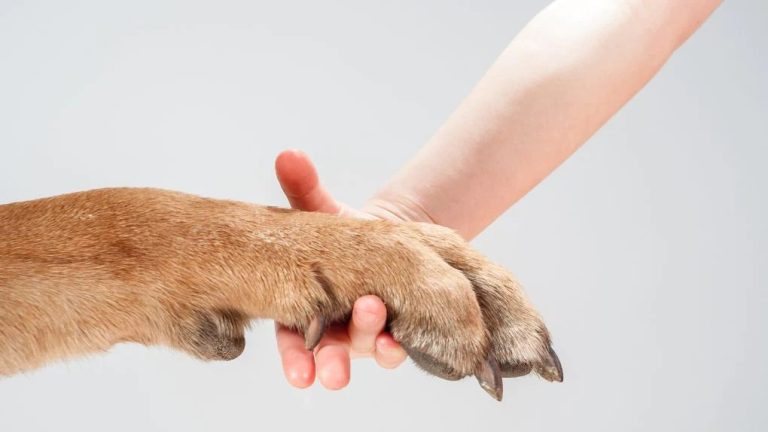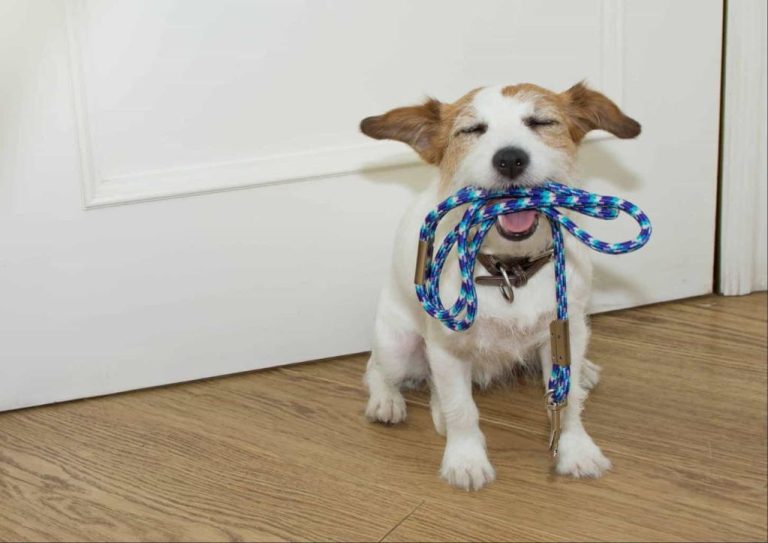Teaching Your Dog To Wait Patiently At Doors
Why Teaching Your Dog to Wait is Important
Teaching your dog to wait patiently at doors is an important behavior to master for several reasons:
It prevents door bolting or escaping, which can be very dangerous. Dogs that bolt out doors can get lost, injured by cars, or become involved in altercations with other animals. According to Poolfencediy.com, 75% of pet door incidents result in injury or death. Having a dog that waits patiently until released prevents opportunities for bolting.
Waiting allows you to enter or exit first, which establishes leadership and structure. Your dog looks to you for cues on what to do next, rather than rushing ahead based on their own impulses. This promotes respect and improves overall behavior.
It keeps your dog calm and focused on you, rather than getting overexcited about the open door. The waiting behavior reinforces impulse control. Rather than obsessing about the door, your dog will pay attention to what you want them to do. This leads to a calmer mentality overall.
Choose a Release Cue
Choosing a unique release cue for your dog is an important first step in training them to wait at doors. The release cue allows your dog to know when they are free to move after staying in one place. According to pettable.com, popular release words for dogs include “OK!” and “Free!”.
Pick a release cue that is distinct, ideally a unique word or short phrase you don’t use frequently in conversation. Using a unique cue prevents accidentally releasing your dog when not intended. Consistency is also key – make sure all family members practice with the exact same release cue when training. Having different cues from different people will confuse your dog.
Start Training Near a Closed Door
To start teaching your dog to wait at doors, begin indoors with no distractions first. Use treats to lure your dog into a sit or down position near a closed door in your home. According to The American Kennel Club, starting with a closed door builds the foundation for waiting patiently. With the dog settled in a sit or down, gradually open the door just a crack – enough so that the dog cannot fit through. Reward the dog with treats and praise for staying put as you slightly open and close the door repeatedly.
This initial training reinforces that the dog should remain in place and not attempt to bolt through doorway openings. Work up to opening the door wider over multiple training sessions. The key is to go slowly, keep sessions brief, and set your dog up for success by not opening the door to a point that would be too tempting to break position. Mastering this foundation first with a closed door teaches impulse control and patience.
Add the Cue
Once your dog is reliably settling into a sit or down position when you start to open the door, you can add a cue word to tell them when to wait. The best cue to use is “wait” as it is a distinctive word that your dog is unlikely to hear in other contexts.
Before opening the door, say “wait” to your dog in a calm, clear voice. Watch to ensure they settle into the sit or down position. If they do, continue opening the door. Give your release cue such as “okay!” before allowing your dog to move past the door threshold.
With consistent repetition, your dog will learn to associate the “wait” cue with remaining seated and not proceeding through the doorway. Say “wait” every single time before opening any door and releasing your dog. Be patient, as it may take a few weeks before your dog fully generalizes this behavior.
According to akc.org, the secret is to “continue to slightly open then close the door until your dog realizes they can’t go through without the release cue.” Repeating this process cements the connection between hearing “wait” and waiting politely at the door.
Increase Distance
Once your dog has reliably learned to wait at the door with you close by, it’s time to increase the distance. As the AKC advises, take steps back away from your dog after giving the “wait” cue (AKC). Start with just a single step back. If your dog breaks the wait, then return to the previous distance where they were successful. But if they continue waiting, praise and reward them.
Slowly take more steps back, increasing the distance between you and your dog. It’s important to gradually build up the duration and distance of the wait over multiple training sessions. Always return and reward your dog for maintaining the wait despite your distance. Eventually work up to being able to walk all the way across the room before releasing your dog to come through the door.

Proof the Behavior
Once your dog has mastered the basics of waiting at the door, it’s time to proof the behavior by practicing with increasing levels of distraction and temptation. Start by opening the door just a crack and see if your dog still waits for the release cue. Gradually open the door wider until it is fully open, being sure to reward your dog for holding the wait. You can also practice with whatever is on the other side of the door being increasingly tempting – have a family member or friend walk by, have another dog walk by, throw treats or a toy outside, etc. The goal is to strengthen your dog’s waiting behavior even when he is dying to go through that door. Be patient and persistent with your training, not moving forward to the next level of distraction until your dog has the previous level mastered. Remember to always reward him heavily for succeeding at each step. According to the ASPCA, “proofing prevents everyday experiences from unraveling all your hard work” (Teach Your Dog to Wait at Doorways).
Practice at Different Doors
Once your dog reliably waits at a single door, it’s time to practice the behavior at different doors around your home and property. Start with lower temptation doors first (like the back door) before practicing at high temptation doors like the front door where they may see people and dogs going by.
It’s important to generalize this behavior because dogs don’t necessarily apply behaviors to all situations naturally (“Fluency and Generalization in Dog Training.” https://www.whole-dog-journal.com/training/fluency-and-generalization-in-dog-training/). Moving between different doors creates new challenges and distractions for your dog to practice waiting patiently.
Begin by practicing at interior doors with little temptation or distraction. Provide your release cue before opening these doors as you initially train this behavior.
Gradually work up to exterior doors, like backyard gates or a garage door, where your dog may be more excited to pass through. Continue rewarding patience and checking for the wait cue at each door.
Finally, practice waiting at your front door. This can be highly tempting for dogs who want to rush outside, so go back to basics with the steps outlined earlier. With ample practice, your dog will learn to generalize waiting politely no matter which door you approach.
Introduce Variable Waiting Times
Once your dog is reliably waiting at doors when you give the release cue, it’s time to introduce more variability into the duration of the waits. If you always release your dog after the same count, they will learn to anticipate exactly when the release is coming. This predictability can undermine the purpose of teaching patient waiting.
To prevent this, start varying the amount of time you have your dog wait before giving the release cue. After asking your dog to wait, randomly wait between 5-30 seconds (gradually working up to 30 seconds) before saying your release word. According to variable duration reinforcement training, rewarding your dog after unpredictable durations is more effective for teaching patience than fixed durations.
Make sure to continue providing praise and treats after releasing your dog. Keep sessions short and fun while your dog is learning this new criteria. With continued practice waiting for variable durations, your dog will generalize this behavior to any door in your home.
Troubleshooting
Teaching a dog to wait at doors often goes smoothly, but some dogs may struggle with certain aspects of training. If your dog is having trouble reliably waiting at the door, here are some tips:
Go back to the previous step your dog was successful at and practice more repetitions there before moving on. For example, if your dog struggles waiting when you’ve moved 5 feet back, spend more time at 3-4 feet until the behavior is solid again. Moving too quickly through the steps can confuse some dogs.
Use higher value treats to motivate your dog, like small pieces of chicken, cheese, or hot dogs. The extra motivation can help reinforce waiting when it becomes more difficult at further distances.1
If your dog breaks the wait, gently close the door and repeat the sequence from the beginning. Consistency is key, so don’t allow the dog to go through the door if they break. This will teach them waiting is mandatory.
Make sure your release cue is clear and distinct. Choose a unique word like “break” or “free” that your dog won’t hear frequently in conversation. Avoid casual phrases like “okay” that can confuse dogs.
Be patient and keep sessions positive and short. Don’t move too quickly or practice for too long. End on a good note with a reward to keep your dog engaged in training.
Maintain the Behavior
Once your dog has mastered waiting patiently at doors, it’s important to continue reinforcing the behavior to maintain it. As your dog becomes reliable at waiting, you can use intermittent reinforcement by occasionally praising without treating to keep the behavior strong (https://www.vet.cornell.edu/departments/riney-canine-health-center/canine-health-information/training-stay-vs-wait).
Continue to praise and reward your dog for waiting at doors, especially in the early stages after training. With time and consistency, you’ll be able to phase out food rewards while still verbally praising. The goal is to reinforce waiting often enough that your dog remains motivated to do it.
You can also practice short training sessions periodically throughout your dog’s life. Ask them to wait at different doors, for variable durations, and before being released with your cue word. This will help solidify the behavior and prevent them from becoming rusty at waiting patiently.
With diligent upkeep and reinforcement, you can maintain a stellar wait at doors for the long term. Just be sure to continue praising and rewarding your dog intermittently so they don’t forget this important skill.





